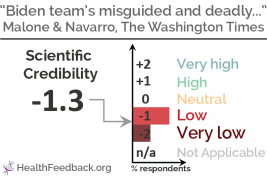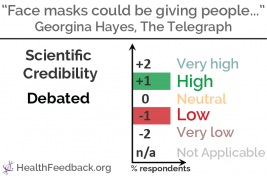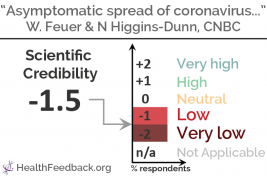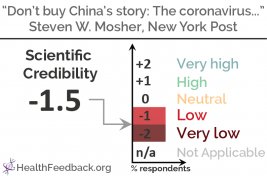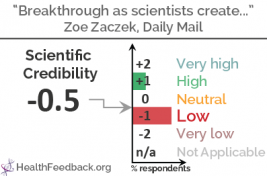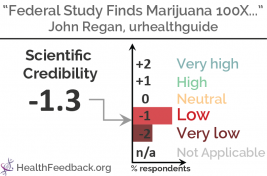.
Articles tagged as: Misleading definition
Washington Times article by Robert Malone and Peter Navarro relies on inaccurate and unsubstantiated claims about virus evolution, vaccine immunity, and COVID-19 vaccine safety
in Washington Times, by Robert Malone and Peter Navarro
“This article has inaccuracies throughout with a clear view to push an anti-vaccine agenda. The picture depicting a skull with eyes and nose made of coronaviruses in the shape of the U.S. is sensationalist. The opening line calls it Biden’s strategy. It was also Trump’s and is the strategy of every country and the WHO.”
— 15 Aug 2021
Misleading Wall Street Journal opinion piece makes the unsubstantiated claim that the U.S. will have herd immunity by April 2021
in Wall Street Journal, by Marty Makary
“The article’s claim that the U.S. is near herd immunity rests on two numbers: 1) the detection of infections by testing (claimed to be 10 – 25 percent) and 2) the infection fatality rate (claimed to be 0.23 percent). Using the same number of deaths as the author indicates that 0.15%/0.6% = 25% of the U.S. population has been infected, rather than two-thirds as the author claims. Thus, the author’s argument that 55 – 66 percent of the U.S. population has already been infected and has immunity is not supported by available data.”
— 26 Feb 2021
New York Post article makes speculative, unsupported claim that mutation could enable the virus causing COVID-19 to evade handwashing and mask-wearing
in New York Post, by Jackie Salo
“The preprint that the article focuses on actually says nothing about the most egregious claim made in the article: that the virus is evolving to get around hand-washing, masks, etc. This comes from a quote from someone who’s not an author on the preprint, giving an opinion about the preprint…on a topic not covered by the preprint.”
— 08 Oct 2020
Telegraph article describing the hypothesis that face masks can variolate a population receives mixed reviews on its scientific accuracy
in The Telegraph, by Georgina Hayes
“The Telegraph headline is obviously misleading but the subheading is accurate. Masks don’t give immunity; rather, the argument is that infections are milder or asymptomatic and allow immunity without severe disease. The article is essentially true to the NEJM commentary, however a reader could become confused and think that the article suggests masks give you COVID-19 immunity.”
— 24 Sep 2020
People who do not show symptoms can contribute to significant COVID-19 transmission, contrary to CNBC report
in CNBC, by William Feuer, Noah Higgins-Dunn
there is already “abundant data” showing that people who are not showing symptoms—which could include asymptomatic, presymptomatic, and paucisymptomatic individuals—comprise about 40 to 50% of COVID-19 cases
— 10 Jun 2020
Viral New York Post article perpetuates the unfounded claim that the virus that causes COVID-19 is manmade
in New York Post, by Steven W. Mosher
Overall, Mosher’s argument is based on unfounded speculation and scientific inaccuracies. Such claims, which continue to be perpetuated even by public officials, have real-world repercussions. Peter Daszak, epidemiologist and president of the EcoHealth Alliance who has collaborated with WIV researchers, warned during an interview with the journal Science: “These rumors and conspiracy theories have real consequences, including threats of violence that have occurred to our colleagues in China.”
— 02 Mar 2020
Daily Mail article misleads with clickbait headline claiming cowpox-derived virus will “kill every type of cancer”
in Daily Mail, by Zoe Zaczek
“This article substantially overhypes early pre-clinical work with a viral therapy that has not yet been tested in even the earliest stages of human clinical trials. The headline is particularly misleading as I can find only three published papers suggesting the therapy has efficacy in lung, breast and colorectal cancers in cell lines and mouse models only.”
— 20 Nov 2019
Article claiming vaccines cause autoimmunity and autism due to fetal DNA contaminants found unsupported and implausible
in Vaccine Impact, by Theresa Deisher
“While the letter provides some concerns about the fetal cell-derived DNA contamination in vaccines, it does not provide any actual evidence to support the claims made. The whole hypothesis of the author (which is misleadingly presented as fact) is based on the author’s own measurements of fetal cell-derived DNA, which has serious methodological problems that could be easily prevented by RNase treatment”
— 09 Jun 2019
New Scientist article accurately summarises polycystic ovary syndrome (PCOS) research but overstates significance of animal studies
in New Scientist, by Alice Klein
“I think that the title overstates the position with the present level of knowledge and is too sensationalist. The ‘ovarian cysts’ stated to typically characterize PCOS are not cysts but follicles and this may be misleading. On the positive side, the quotes from Professor Robert Norman are spot on and accurately quoted (see Annotations below).”
— 17 Jan 2019
2018’s most popular health article promoting cannabis’ safety found to be biased and misleading
in urhealthguide, by John Regan
“The article fails to point out that only very limited, low-quality evidence supports the use of cannabis for treating chronic pain. The article also fails to describe the potential harms of cannabis. Although it does not cause fatal overdose, it does cause intoxication and impairment, and driving under the influence is dangerous. Also, both acute and chronic use of cannabis cause cognitive impairment which can interfere with an individual’s safety and productivity.”
— 20 Dec 2018

